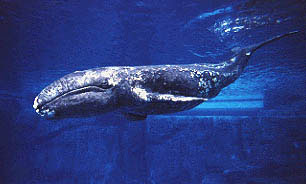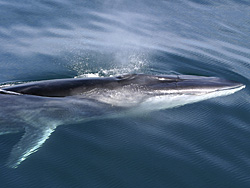
Eschrichtiidae or the gray whales is a family of baleen whale with a single extant species, the gray whale, as well as four described fossil genera: Archaeschrichtius (Miocene), Glaucobalaena and Eschrichtioides (Pliocene) from Italy, and Gricetoides from the Pliocene of North Carolina. Some phylogenetic studies have found this family to be invalid, with its members nesting inside of the clade Balaenopteridae. The names of the extant genus and the family honours Danish zoologist Daniel Eschricht.
Physeter is a genus of toothed whales. There is only one living species in this genus: the sperm whale. Some extremely poorly known fossil species have also been assigned to the same genus including Physeter antiquus from the Pliocene of France, and Physeter vetus from the Quaternary of the U.S. state of Georgia. Physeter vetus is very likely an invalid species, as the few teeth that were used to identify this species appear to be identical to those of another toothed whale, Orycterocetus quadratidens.

Kogiidae is a family comprising at least two extant species of Cetacea, the pygmy and dwarf sperm whales. As their common names suggest, they somewhat resemble sperm whales, with squared heads and small lower jaws, but are much smaller, with much shorter skulls and more notable dorsal fins than sperm whales. Kogiids are also characterized by a "false gill slit" behind their eyes.

Balaenoptera is a genus of rorquals containing eight extant species. Balaenoptera comprises all but two of the extant species in its family ; the genus is currently polyphyletic, with the two aforementioned species being phylogenetically nested within it.

Pseudorca is a genus of cetaceans with three members which include Pseudorca yokoyamai, Pseudorca yuanliensis and Pseudorca crassidens, of which P. crassidens is the only extant member.

Lagenorhynchus is a genus of oceanic dolphins in the infraorder Cetacea, presently containing six extant species. However, there is consistent molecular evidence that the genus is polyphyletic and several of the species are likely to be moved to other genera. In addition, the extinct species Lagenorhynchus harmatuki is also classified in this genus.

Carcharhinus is the type genus of the family Carcharhinidae, the requiem sharks. One of 12 genera in its family, it contains over half of the species therein. It contains 35 extant and eight extinct species to date, with likely more species yet to be described.

Cetotherium is an extinct genus of baleen whales from the family Cetotheriidae.

Aulophyseter is an extinct genus of sperm whales from the Miocene formations of the west and east coasts of North America.
Ashorocetus is a monotypic genus of an extinct primitive baleen whale of the family Aetiocetidae. It was named by Barnes et al. 1995, and contains one species, A. eguchii. Fossils of this whale are found from the Chattian Morawan formation, near Ashoro, of upper Oligocene Hokkaido, Japan. Ashorocetus eguchii was described based on a partial skull and is named after the type locality and Kenichiro Eguchi of the Ashoro Museum of Paleontology.
Morawanocetus is a genus of extinct primitive baleen whale from the family Aetiocetidae that existed during the Chattian stage of the Oligocene epoch.
Willungacetus is an extinct genus of primitive baleen whale of the family Aetiocetidae known from the Oligocene of Australia. It is the oldest-known whale from Australia, and the only aetiocetid whale currently known from the Southern Hemisphere.

Cetotheriidae is a family of baleen whales. The family is known to have existed from the Late Oligocene to the Early Pleistocene before going extinct. Although some phylogenetic studies conducted by Fordyce & Marx 2013 recovered the living pygmy right whale as a member of Cetotheriidae, making the pygmy right whale the only living cetotheriid, other authors either dispute this placement or recover Neobalaenidae as a sister group to Cetotheriidae.

Parietobalaena is an extinct genus of baleen whale, belonging to the family Pelocetidae. Fossils are found in Miocene-aged marine strata in North America, Europe, Australia, and Japan, including the Temblor and Itahashi formations. Based on previous estimates of juvenile specimens, Tsai (2017) suggested a body size of 12-15 m for P. yamaokai, akin to that of the gray whale.
Physeterula was a prehistoric close relative of the sperm whale from the Miocene. Its fossils have been found in Europe and the United States.

Squalodontidae or the shark-toothed dolphins is an extinct family of large toothed whales who had long narrow jaws. Squalodontids are known from all continents except Antarctica, from the Oligocene to the Neogene, but they had a maximal diversity and global distribution during the Late Oligocene and Early to Middle Miocene.

Eschrichtioides is an extinct genus of baleen whale known from the early Pliocene of Northern Italy. Its type species, E. gastaldii, had a complex taxonomic history, starting as a cetothere, then as an extinct member of Balaenoptera, before being finally recognized as a relative of the gray whale.
Pontobasileus is an archaeocete whale known from a fragment of a single tooth described by Leidy 1873. It can questionably be dated to the Eocene of Alabama.

Idiorophus is a genus of extinct toothed whales in the family Physeteridae. Fossils have been found in the Colhuehuapian Gaiman Formation of Argentina and the Libano Sandstone in Italy.
Xhosacetus is a genus of ziphiid cetaceans with a single species, Xhosacetus hendeysi. It was classified from fossils found off the coast of the Kerguelen islands in 1,145 meter deep water.











